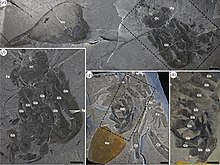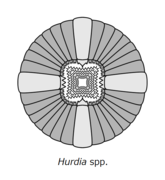Hurdia
| Hurdia Temporal range: Mid Cambrian,
| |
|---|---|

| |
| Reconstruction of H. victoria (top) and H. triangulata | |

| |
| Disarticulated fossils | |
| Scientific classification | |
| Domain: | Eukaryota |
| Kingdom: | Animalia |
| Phylum: | Arthropoda |
| Class: | †Dinocaridida |
| Order: | †Radiodonta |
| Family: | †Hurdiidae |
| Genus: | †Hurdia Walcott, 1912 |
| Type species | |
| †Hurdia victoria Walcott, 1912
| |
| Other species | |
| |
Hurdia is an extinct genus of hurdiid radiodont that lived 505 million years ago during the Cambrian Period. Fossils have been found in North America, China and the Czech Republic.
Description[edit]
Hurdia was one of the largest organisms in the Cambrian oceans, H. victoria reached approximately 30 cm (12 in) in length, while H. triangulata reached up to just 8 cm (3.1 in).[1] Its head bore a pair of frontal appendages. These frontal appendages had 9 or more rarely 10 or 11 segments/podomeres, which were approximately rectangular and decreased in size towards the end of the appendage. The upper surface of the appendage was convexly curved. Podomeres 2 to 6 bore long downward pointing spines (ventral spines) with forward-curving tips. These ventral spines themselves bore up to 9 equally spaced forward-facing spines dubbed auxiliary spines, with podomeres 7 and 8 bearing shorter, smooth forward curving spines. The frontal appenages were used to bring food to its ring-shaped mouth (oral cone), in which four large plates are present, with inner rows of spines inside the main cone.[2] Like other hurdiids, Hurdia bore a large frontal carapace protruding from its head composed of three sclerites: a central component known as the H-element and two lateral components known as P-elements. Originally, it is estimated that body flaps ran along the sides of the organisms, from which large gills were suspended.[3] However, anatomy of Aegirocassis clarified that Hurdia had both ventral and dorsal flaps, and gills were on trunk segments.[4]
Ecology[edit]
Hurdia is either suggested to have used its frontal appendages to sift small prey from sediment, or to have used them as a trap to capture larger benthic (seafloor dwelling) prey.[5]
Distribution[edit]
Hurdia had cosmopolitan distribution; it has been recovered from the Burgess Shale in British Columbia, Canada, as well the Spence Shale and Wheeler Shale in Utah, USA, the Shuijingtuo Formation in Hubei, China, and the Jince Formation of the Czech Republic.[3][2]
Taxonomic history[edit]
Hurdia was named in 1912 by Charles Walcott, with two species, the type species H. victoria and a referred species, H. triangulata.[6] The genus name refers to Mount Hurd.[6] It is possible that Walcott had described a specimen the year prior as Amiella, but the specimen is too fragmentary to identify with certainty, so Amiella is a nomen dubium.[7] Walcott's original specimens consisted only of H-elements of the frontal carapace, which he interpreted as being the carapace of an unidentified type of crustacean. P-elements of the carapace were described as a separate genus, Proboscicaris, in 1962.
In 1996, then-curator of the Royal Ontario Museum Desmond H. Collins erected the taxon Radiodonta to encompass Anomalocaris and its close relatives, and included both Hurdia and Proboscicaris in the group.[8] He subsequently recognized that Proboscicaris and Hurdia were based on different parts of the same animal, and recognized that a specimen previously assigned to Peytoia was also a specimen of the species.[7] He presented his ideas in informal articles,[9][10] and it was not until 2009, after three years of painstaking research, that the complete organism was reconstructed.[3][11][12][13]
Sixty-nine specimens of Hurdia are known from the Greater Phyllopod bed, where they comprise 0.13% of the community.[14]
See also[edit]
References[edit]
- ^ Lerosey-Aubril, Rudy; Pates, Stephen (2018-09-14). "New suspension-feeding radiodont suggests evolution of microplanktivory in Cambrian macronekton". Nature Communications. 9 (1): 3774. Bibcode:2018NatCo...9.3774L. doi:10.1038/s41467-018-06229-7. ISSN 2041-1723. PMC 6138677. PMID 30218075.
- ^ a b Daley, Allison C.; Budd, Graham E.; Caron, Jean-Bernard (October 2013). "Morphology and systematics of the anomalocaridid arthropod Hurdia from the Middle Cambrian of British Columbia and Utah". Journal of Systematic Palaeontology. 11 (7): 743–787. doi:10.1080/14772019.2012.732723. ISSN 1477-2019. S2CID 86465719.
- ^ a b c Daley, A. C.; Budd, G. E.; Caron, J. B.; Edgecombe, G. D.; Collins, D. (2009). "The Burgess Shale anomalocaridid Hurdia and its significance for early euarthropod evolution". Science. 323 (5921): 1597–1600. Bibcode:2009Sci...323.1597D. doi:10.1126/science.1169514. PMID 19299617. S2CID 206517995.
- ^ Van Roy, Peter; Daley, Allison C.; Briggs, Derek E. G. (2015). "Anomalocaridid trunk limb homology revealed by a giant filter-feeder with paired flaps". Nature. 522 (7554): 77–80. Bibcode:2015Natur.522...77V. doi:10.1038/nature14256. ISSN 1476-4687. PMID 25762145. S2CID 205242881.
- ^ De Vivo, Giacinto; Lautenschlager, Stephan; Vinther, Jakob (2021-07-28). "Three-dimensional modelling, disparity and ecology of the first Cambrian apex predators". Proceedings of the Royal Society B: Biological Sciences. 288 (1955): 20211176. doi:10.1098/rspb.2021.1176. ISSN 0962-8452. PMC 8292756. PMID 34284622.
- ^ a b Walcott, Charles D. (1912-03-13). "Middle Cambrian Branchiopoda, Malacostraca, Trilobita, and Merostomata". Smithsonian Miscellaneous Collections. 57 (6).
- ^ a b Daley, Allison C.; Budd, Graham E.; Caron, Jean-Bernard (2013). "Morphology and systematics of the anomalocaridid arthropod Hurdia from the Middle Cambrian of British Columbia and Utah". Journal of Systematic Palaeontology. 11 (7): 743–787. doi:10.1080/14772019.2012.732723. S2CID 86465719.
- ^ Collins, Desmond (1996). "The "Evolution" of Anomalocaris and Its Classification in the Arthropod Class Dinocarida (nov.) and Order Radiodonta (nov.)". Journal of Paleontology. 70 (2): 280–293. Bibcode:1996JPal...70..280C. doi:10.1017/S0022336000023362. JSTOR 1306391. S2CID 131622496.
- ^ D. Collins, in North American Paleontological Convention, Chicago, Abstracts with Programs, S. Lidgard, P. R. Crane, Eds. (The Paleontological Society, Special Publication 6, Chicago, IL, 1992), p. 66, 11.
- ^ D. Collins (1999). "Dinocarids: the first monster predators on earth". Rotunda. Vol. 32. Royal Ontario Museum. p. 25.
- ^ Fossil fragments reveal 500-million-year-old monster predator.
- ^ New animal discovered by Canadian researcher.
- ^ Scientists identify T-Rex of the sea
- ^ Caron, Jean-Bernard; Jackson, Donald A. (October 2006). "Taphonomy of the Greater Phyllopod Bed community, Burgess Shale". PALAIOS. 21 (5): 451–65. Bibcode:2006Palai..21..451C. doi:10.2110/palo.2003.P05-070R. JSTOR 20173022. S2CID 53646959.
External links[edit]
- "Hurdia victoria". Burgess Shale Fossil Gallery. Virtual Museum of Canada. 2011. Archived from the original on 2020-11-12.






